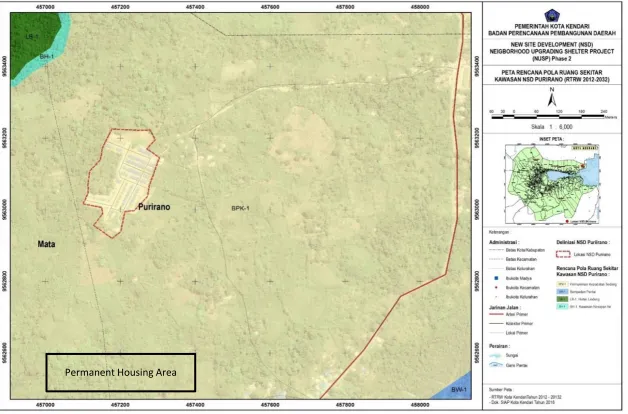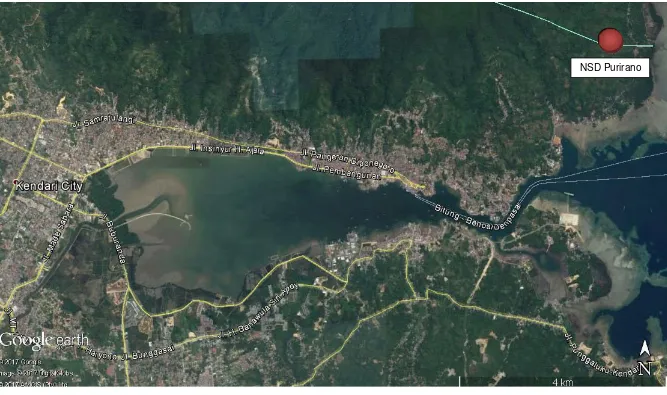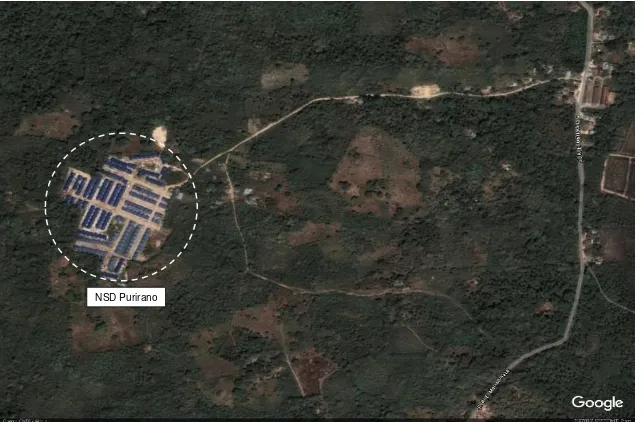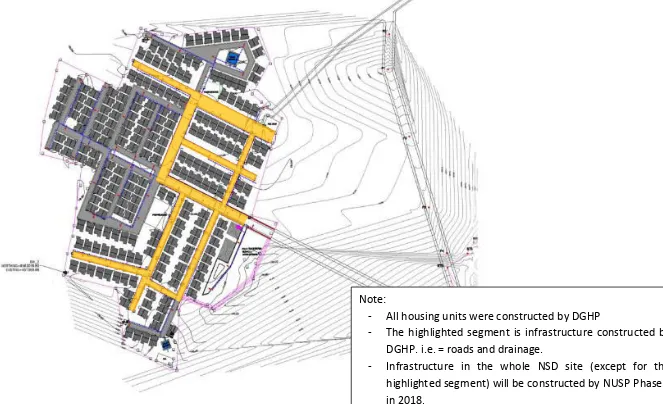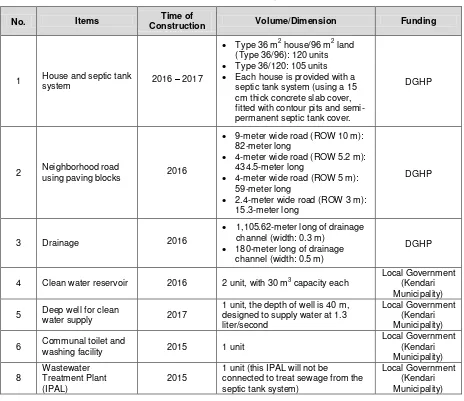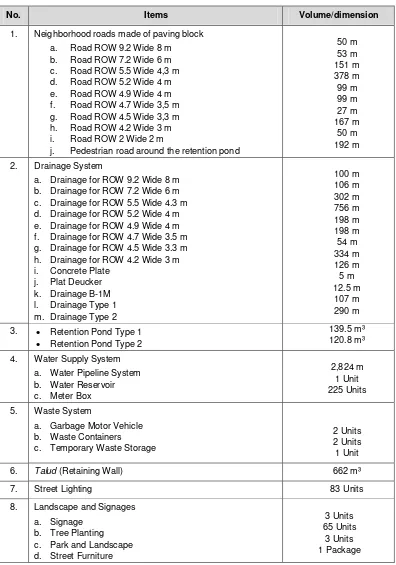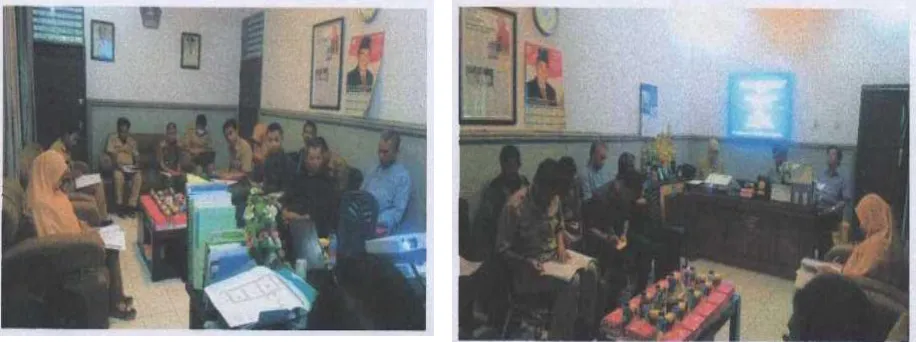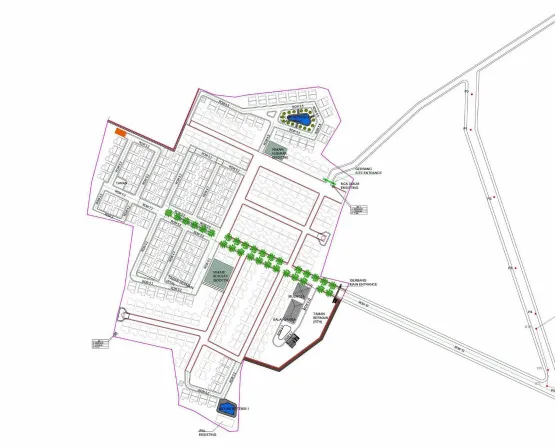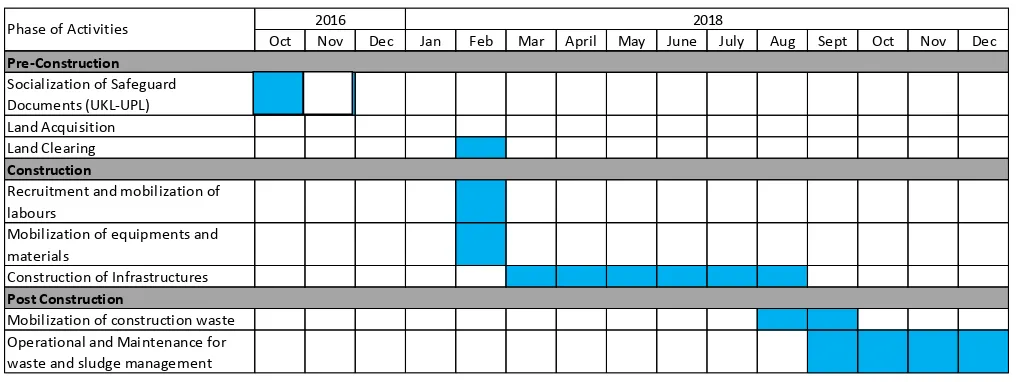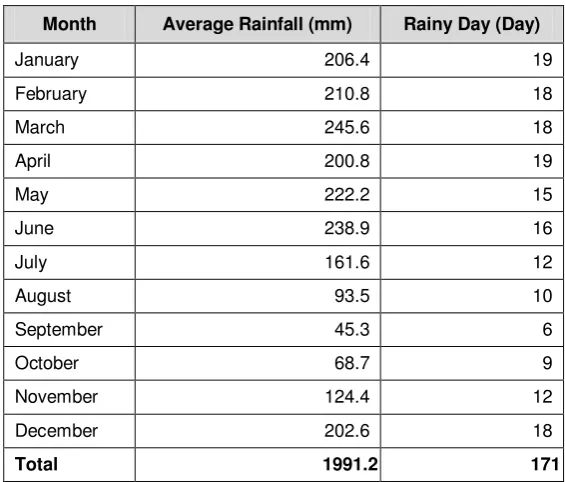Initial Environmental Examination
March 2018
Indonesia: Neighborhood Upgrading and Shelter
Project – Phase 2
CURRENCY EQUIVALENTS (as of 15 March 2018) Currency unit – rupiah (Rp)
Rp1.00 = $0,0000725 $1.00 = Rp13,783
ABBREVIATIONS
ADB – Asian Development Bank
APBD – Anggaran Pendapatan dan Belanja Daerah (Regional Budget for Income and Expenditure)
DGHS – Directorate General of Human Settlements
NOTES
(i) The fiscal year (FY) of the Government of Indonesia and its agencies ends on 31 December. “FY” before a calendar year denotes the year in which the fiscal year ends, e.g., FY2011 ends on 31 December 2011.
(ii) In this report, "$" refers to US dollars.
TABLE OF CONTENTS
ABBREVIATIONS ... iv
LIST OF FIGURES ... v
LIST OF TABLES ... vi
LIST OF APPENDICES ... vii
EXECUTIVE SUMMARY ... viii
Chapter 1 Introduction ...1
1.1 Project Background ...1
1.2 Objective of the Initial Environmental Examination ...2
Chapter 2 Environmental Policy Legal and Administrative Framework ...3
2.1 ADB Environmental Safeguard Policy ...3
2.2 Requirements of Government of Indonesia ...3
Chapter 3 Project Description ...5
3.1 The Need for NSD Implementation ...5
3.2 Existing Development ...5
3.3 Future Development ...10
3.3.1 Pre-construction Phase ...11
3.3.2 Construction Phase ...13
3.3.3 Post-construction Phase ...14
3.3.4 Schedule of Future Development ...17
Chapter 4 Environmental and Social Baseline...18
4.1 Climate ...18
4.2 Ambient Air Quality ...18
4.3 Ambient Noise Level...19
4.4 Topography and Soil ...19
4.5 Groundwater Resources and Quality ...19
4.6 Flora ...20
4.7 Fauna ...21
4.8 Population, Livelihood, and Archaeological Site ...21
4.9 Drainage Water Quality ...21
Chapter 5 Anticipated Environmental Impacts and Mitigation Measures ...23
5.2 Construction Phase ...24
5.3 Maintenance/Operation Phase ...28
Chapter 6 Public Consultation and Information Disclosure ...30
6.1 Public Consultation ...30
6.2 Information Disclosure ...30
Chapter 7 Grievance Redress Mechanism ...31
Chapter 8 Environmental Management Plan (EMP) ...33
8.1 Mitigation Measures ...33
8.2 Monitoring Requirements ...37
8.3 Institutional Arrangement ...43
8.4 Cost Estimate for EMP Implementation ...44
8.5 Reporting Procedures...45
Chapter 9 Conclusions ...46
Chapter 10 References ...47
ABBREVIATIONS
ADB : Asian Development Bank
AMDAL : Environmental Impact Assessment
Bappeda : Development Planning Agency (at city level)
CIO : Community Implementing Organization
BLH : Environmental Agency (at city level)
BMKG : Meteorological, Climatological and Geophysical Agency
BOD : Biochemical Oxygen Demand
BPN : National Land Agency (at city level)
CA : Community Advisory
CC : City Coordinator
COD : Chemical Oxygen Demand
DGHP : Directorate General of Housing Provision
DGHS : Directorate General of Human Settlements
EMP : Environmental Management Plan
IEE : Initial Environmental Examination
IPLT : Sewage Treatment Plant
LCO : Local Coordinating Office
MASL : Meter above sea level
MBR : Low Income Community
NGOs : Non-Government Organizations
NSD : New Site Development
NUSP : Neighborhood Upgrading and Shelter Project
O & M : Operation and Maintenance
PIU : Project Implementation Unit (locally known as “Satker”)
PDAM : Local government-owned Water Supply Company
PLN : State-owned Electricity Company
PMU : Project Management Unit
PPK : Commitment Officer
RMC : Regional Management Consultant
RPJMN : National Medium-Term Development Plan
RTH : Green Open Space
RTRW : Spatial Plan (at city level)
SATKER : Project Implementation Unit
SIAP : Slum Improvement Action Plan
SPS : Safeguard Policy Statement
TPA : Municipal waste landfill
TPS : Temporary domestic waste storage site/shelter
TSS : Total suspended solid
UKL-UPL Environmental Management Effort - Environmental Monitoring Effort Document
UMP : Provincial Minimum Wages
LIST OF FIGURES
Figure 1 The Purirano NSD Site Designated in the Spatial Plan of Kendari City ...6
Figure 2 Purirano NSD Site in Kendari City ...7
Figure 3 Aerial View of Existing Purirano NSD Site ...8
Figure 4 Existing Development of Purirano NSD ...9
Figure 5 Evaluation of UKL-UPL Document of Purirano NSD ...12
Figure 6 Landscaping Plan...16
LIST OF TABLES
Table 1 Existing Development ...10
Table 2 Facility and Infrastructure to be constructed ...11
Table 3 Schedule of NSD Implementation ...17
Table 4 Rainfall Recorded in Kendari City in 2005 - 2015 ...18
Table 5 Ambient Air Quality Inside and Outside Purirano NSD ...19
Table 6 Result of Water Quality Testing ...19
Table 7 Types of Flora at Purirano NSD...20
Table 8 Types of Fauna at Purirano NSD ...21
Table 9 Drainage Water Analytical Result ...22
Table 10 Environmental Mitigation Measures ...33
Table 11 Environmental Monitoring Requirements ...38
Table 12 Roles and Responsibilities on EMP Implementation and Reporting ...43
LIST OF APPENDICES
Appendix 1 Decree of Head of Environmental Agency in Kendari City about UKL-UPL Approval
at NSD Locations in Kendari City ...49
Appendix 2 Environment Permit (Izin Lingkungan) ...54
Appendix 3 Local Regulation No 1/2012 about Kendari Spatial Plan ...59
Appendix 4 Statement Letter (Surat Keterangan) Reference Number 593/3633 ...60
Appendix 5 Statement Letter (Surat Keterangan) Reference Number 032/5746 ...61
Appendix 6 Kendari Mayor's Letter about Location Compliance Statement to RTRW and Support of New Site Development (NSD) Activities in Kendari City ...62
Appendix 7 List of Attendance ...63
Appendix 8 Minute of Dissemination (Material of Dissemination is not available) ...64
Appendix 9 Ambient Air Quality Inside and Outside Purirano NSD...65
EXECUTIVE SUMMARY
1 Project background. The Neighborhood Upgrading and Shelter Project - Phase 2 (NUSP-2) is a community driven development project included in the National Medium-Term Development Plan (known as RPJMN) 2015 - 2019 of Indonesian Government with the objective to achieve the “Cities without Slums Program” and address ongoing issues related to rapid urbanization. The project will be implemented in 20 cities, supported by the Asian Development Bank (ADB) and executed by the Directorate General of Human Settlements (DGHS) - the Ministry of Public Works and Housing (MPWH). This project is expected to contribute towards meeting the Millennium Development Goals (MDG), particularly in improving the lives of slum dwellers and reducing (by half) the proportion of households without sustainable access to safe drinking water and basic sanitation.
2 Kendari City as the capital of Southeast Sulawesi Province encounters rapid urbanization and high population growth of about 2.8% per annum. These conditions have resulted in that the low-income families are forced to settle in disadvantaged neighborhoods (slum settlements) without basic sanitation and safe drinking water due to lacking financial resources and infrastructure. The slum settlements in Kendari City have reached about 497.27 hectares and are distributed in 53 neighborhoods. This city has been selected to participate in the NUSP-2 and developed the Slum Improvement Action Plan (SIAP) in 2015 as required to implement the project.
3 Environmental safeguards. Asian Development Bank (ADB) will finance the
construction of facility and infrastructure for the NSD in Kelurahan Purirano (Purirano NSD), Kendari city; and therefore, according to ADB's Safeguard Policy Statement (ADB SPS 2009) on Environment and the Environmental Assessment and Review Framework (EARF) document prepared by the DGHS for the NUSP Phase 2 Project (January 2014), an Initial Environmental Examination (IEE) for this Category B Project is required. In addition, the NUSP-2 has secured the approval for the environmental management and monitoring effort (known as UKL-UPL) document and obtained the Environmental Permit for the Purirano NSD on 29 December 2016 from the Environmental Agency of Kendari Municipality to comply with the requirements of Government Regulation No. 27/2012 on Environmental Permitting. This IEE and UKL-UPL are the environmental safeguard documents that should be complied by the Project Executing Agency during the project implementation.
Municipality). the Public Work Agency of Kendari Municipality.
6 The construction that will be funded by ADB is presented in the following table.
Items Planned Facility and Construction
Neighborhood road (paving blocks) 1,266 m in total (2 to 8-meter width)
Open drainage channel (cemented gravel/cobble) 2,589 m in total
Storm water retention pond (unlined) 260 m2
Clean water supply
- Pipeline (high density poly ethylene) - Elevated reservoir (concrete) - Meter box
2,824 m in total 30 m3
225 units
Household (solid) waste management Temporary waste disposal storage/shelter 2 units of garbage motor vehicle
2 large waste bins Retaining wall for areas prone to landslide/erosion 662 m3
Street lighting* 83 units
Landscaping and signage 1 package
Note: *Power pole and erection will be undertaken by the state-owned electricity company PT PLN.
7 Prior to commencing the construction (pre-construction phase) at the Purirano NSD, the PMU requires the local government (Kendari Municipality) to carry out the dissemination on the project, including its anticipated disturbance and environmental impacts as well as corresponding migration measures; and to establish a Grievance Redress Mechanism (GRM). The construction phase will include: recruitment of construction labors; mobilization of equipment and construction materials; and construction of facility and infrastructure itself as presented in the above table. Upon completion of the construction activity, the Contractor will maintain the facility and infrastructure already constructed for 6-month period.
8 Environmental and social baseline conditions. The Purirano NSD has an elevation of approximately 60 - 75 meters above sea level, and a slope of 8 - 15%. The highest rainfall was about 245 mm in March whereas the lowest rainfall was about 45 mm in September based on the average data recorded from 2005 to 2015.
dB(A) which is the threshold value stipulated by the Ministry of Environment Decree No. 48/1996 on Noise Level Standard.
10 The groundwater quality for the clean water supply at Purirano NSD are still relatively good as the key parameters analyzed (i.e. pH, iron, fluoride, chloride, manganese, sulfate, and coliform) are below the threshold values stipulated in the Ministry of Health Regulation No. 416/1990, Attachment II on Clean Water Quality Standard.
11 There are no flora and fauna species identified at the Purirano NSD categorized as endemic, rare, protected or other conservation status. Further, there is no nearby stream, river or sea considered ecologically important within the neighborhood.
12 Based on the statistical data of Kendari in Number Year 2015, the number of residents in Kelurahan Purirano was 1,256 people, comprising 348 families. About 815 people (163 families) were categorized low-income family, with an average income of 1 - 2 million rupiah/month. This low-income family primarily works in the informal sector such as fishermen, daily labors, and farmers. The population density is 541/km2 categorized as low-density population area. Culturally, there is neither historical building nor archaeological site located in the Purirano NSD site.
13 Anticipated environmental impacts and planned mitigation measures. The pre-construction, construction and maintenance/operation activities will generate relatively minimal environmental impacts limited within the Purirano NSD site. If well managed, these impacts are unlikely to be encountered beyond the perimeter of the site. The impacts of this type of neighborhood development are anticipated on: public perception and attitude towards the project and contractors; ambient air quality and noise level; sedimentation and surface water quality; groundwater resources; work and business opportunities; and occupational health, safety and hygiene.
14 Corresponding measures that should be implemented to mitigate the environmental impacts mentioned earlier are, among others:
Conduct dissemination about the project and planned activity prior to the construction phase and during maintenance period;
Establish a Grievance Redress Mechanism to manage complaints and concerns raised by the community and other stakeholders in a structured manner;
Conduct water spraying of the construction sites as well as along the main road leading to the Purirano NSD construction at least once per day or more frequent during dusty road condition;
Construct and maintain a temporary drainage channel and settling ponds to manage runoff and siltation during the construction period; Limit groundwater abstraction up to 1.3 liter/second and for a period of up to 8 hours per day to reduce the drawdown of groundwater table;
to work as construction labor;
Provide and maintain adequate toilet, bathing and washing facilities at the construction site.
15 The mitigation measures and monitoring requirements are detailed in the Environmental Management Plan (EMP) of this IEE, including the distribution of responsibilities of the Contractor, City Satker and Local Coordinating Office within the Kendari Municipality, and Project Management Unit – the Directorate General of Housing Settlements. The project has estimated a cost of USD 9,135 will be required for implementing the mitigation measures and monitoring requirements defined in the EMP.
Chapter 1 Introduction
1.1 Project Background
1 The Neighborhood Upgrading and Shelter Project Phase 2 (NUSP-2) is a community driven development project stated in the 2015 - 2019 National Medium-Term Development Plan of Indonesian Government. Implementation of the NUSP-2 project is underway to achieve the “Cities without Slums Program” and address ongoing issues on slum settlements related to rapid urbanization. This project will be implemented in 20 cities, supported by the Asian Development Bank (ADB) and executed by the Ministry of Public Works and Housing (MPWH), particularly the Directorate General of Human Settlements (DGHS) as the key Project Executing Agency (EA). The main tasks of the DGHS are to develop and implement inclusive pro-poor city development plans and improve living conditions in slum areas.
2 The NUSP-2 project is implemented through collaborative works involving: the DGHS to construct infrastructure; the Directorate General of Housing Provision (DGHP) to construct the houses; and the selected local government (regency/municipality) to provide at least 2-hectare vacant land ready for the establishment of new site development. This project is expected to contribute towards meeting the Millennium Development Goals (MDG), particularly to improve the lives of slum dwellers and to reduce (by half) the proportion of households without sustainable access to safe drinking water and basic sanitation. The outputs of the project are:
Institutional capacities for managing pro-poor urban development strengthened; Infrastructure in slum neighborhood upgraded; and
New settlements for poor families established.
3 Kendari City as the capital of South-east Sulawesi Province has been selected as one of the participating city of the NUSP Phase 2 Project. Like other growing cities in Indonesia, Kendari City encounters rapid urbanization and high population growth of about 2.8% per annum. These conditions have resulted in that the low-income families are forced to settle in disadvantaged neighborhoods (slum settlements) without basic sanitation infrastructure due to lack of financial resources and affordable housing. These slum settlements have been identified in coastal areas, river banks, economic activity centers and protected areas. The local government (Kendari Municipality) as the city administration has undertaken field verification that the slum settlements in the city have reached about 497.27 hectares, and these settlements are distributed in 53 neighborhoods. The existence of these slum settlements is confirmed through the Mayor of Kendari Decree No. 767/2014 (this Decree has no date) on Determination of Slum Neighborhoods in Kendari City.
1.2 Objective of the Initial Environmental Examination
5 ADB will support the construction of facilities and infrastructure for the Purirano NSD in Kendari city; and therefore, as part of ADB's Safeguard Policy Statement (ADB SPS 2009) on Environment, an Initial Environmental Examination (IEE) for this scope of work should be developed. The IEE development is mandated in the Environmental Assessment and Review Framework document prepared by the Directorate General of Human Settlements (DGHS or known as Direktorat Jenderal Cipta Karya)for the NUSP Phase 2 Project (January 2014). This IEE is prepared by the local government (Kendari Municipality), as integral part of the Purirano NSD proposal, for subsequent endorsement by DGHS and ADB.
6 The IEE is the reference document to assess environmental impacts and set Environmental Management Plan (EMP), defining mitigation measures and monitoring requirements based on the anticipated impacts to be undertaken by the project in implementing the Purirano NSD development including its housing infrastructure. This IEE, particularly the EMP, should be used by the Executing Agencies at national, provincial and city levels (based on their respective functions) to implement mitigation measures in reducing the project’s impacts and monitor effectiveness of such measures during the pre-construction, construction and operation phases. The IEE does not replace the Environmental Management Effort - Environmental Monitoring Effort document (UKL-UPL) that has been prepared and approved by the Environmental Agency of Kendari in December 2016, and therefore the requirements of both IEE and UKL-UPL should be implemented by the Project Executing Agency and/or its appointed local authorities. (Appendices 1 and 2).
Chapter 2 Environmental Policy Legal and Administrative Framework
2.1 ADB Environmental Safeguard Policy
8 ADB requires environmental safeguard measures in all aspects of ADB operations, in accordance with ADB SPS 2009, which states that ADB requires an environmental assessment of all activity loans, program loans, sectoral loans, loan sector development programs, and loans involving financial agent, and private sector loans. The type of environmental assessment required depends on the nature, magnitude, significance, and sensitivity of environmental impact of the project. ADB uses the following categorization to screen expected environmental impacts of a Project:
Category A: Projects could have significant and adverse environmental impacts that are irreversible, diverse, or unprecedented. These impacts may affect an area larger than the sites or facilities subject to physical works. An Environmental Impact Assessment (EIA) is required for the category A project.
Category B: Projects could have some adverse environmental impacts, but of less degree or significance than those of category A. These impacts are site-specific and can be readily addressed through common mitigation measures. An Initial Environmental Examination (IEE) is required for the category B project.
Category C: Projects are likely to have minimal or no adverse environmental impacts. No environmental assessment is required although environmental implications need to be reviewed.
Category Financial Intermediary (FI): Projects involves a credit line through financial intermediary or an equity investment. The FI must apply for an environmental management system.
9 The Purirano NSD development in Kendari City including the construction or upgrading of its infrastructure, will improve the welfare of its community, and is expected to generate typical impacts associated with relatively small-scale building and infrastructure construction activities. These impacts, which neither adverse nor significance, can be readily mitigated with common mitigation measures. Therefore, the IEE is required for the mentioned NSD as the environmental safeguard document required by ADB.
2.2 Requirements of Government of Indonesia
and/or activity. Based on the AMDAL or UKL-UPL approval, the mentioned GR 27/2012 requires that the business and/or activity apply for the Environmental Permit (Izin Lingkungan) to the same government authority granting the AMDAL and UKL-UPL approval.
11 Activities that do not require either AMDAL or UKL-UPL should submit a statement letter regarding the commitment to undertake environmental management and monitoring (Surat Pernyataan Pengelolaan dan Pemantauan Lingkungan or SPPL).
12 Other key regulations related to the environmental assessment that are adhered to by the Purirano NSD development are as follows:
i. Minister of Environment Regulation No. 5/2012 on Type of Business and/or Activity Requiring AMDAL.
ii. Minister of Environment Regulation No. 16/2012 on Guidelines for the Preparation of Environmental Documents.
iii. Minister of Public Works Regulation No. 10/PRT/M/2008 on Types of Business and/or Activity in Public Works Sector Requiring UKL-UPL.
Chapter 3 Project Description
3.1 The Need for NSD Implementation
14 Following the implementation of the project, the local government (Kendari Municipality) has undertaken assessment of potential beneficiaries (i.e., low-income families) of Punggaloba and Purirano neighborhoods who are entitled to resettlement to the Purirano NSD. To this end, the construction of houses in Purirano NSD was commenced in 2016, and this was progressed through to 2017. Some facilities and infrastructure have also been constructed in 2017.
15 Neighborhood roads, clean water supply, and communal park/playground are among others the public facilities and infrastructure that will be constructed at the Purirano NSD using ADB funding in 2018. This construction is important undertaking for the Purirano NSD and its residents in terms of providing safe mobility, social interaction, and affordable access to basic sanitation facilities. The following sub-sections describe both the existing and future development of the Purirano NSD.
3.2 Existing Development
16 The local government (Kendari Municipality) has provided approximately 4.19-hectare land for the Purirano NSD on R. E. Martadinata Street, in Purirano neighborhood, Kendari City. The use of this area for this NSD has been legally designated as permanent housing area based on the Spatial Plan (Rencana Tata Ruang Wilayah or RTRW) of Kendari City for 2012 – 2032 based on Local Regulation (Peraturan Daerah) No. 1/2012 (dated 29 February 2012) issued by the Mayor of Kendari and the Local House of Representative (Dewan Perwakilan Rakyat Daerah or DPRD) of Kendari City (Appendix 3). The site designated in the RTRW for the Purirano NSD is shown in Figure 1. The location of Purirano NSD in Kendari city is shown in Figure 2.
17 The local government (Kendari Municipality) owns the land mentioned earlier based on the Statement Letter (Surat Keterangan) No. 593/3633 and 032/5746 issued by the Regional Secretary of Kendari City (these letters have no date). Further, this land ownership by the local government is also endorsed by the DPRD of Kendari City Letter No. 648.2/177/DPRD/2015 (dated 5 May 2015) concerning Approval of Utilization of Land Ownership by the Local Government (Kendari Municipality). These three letters are included in Appendices 4, 5 and 6.
Figure 2 Purirano NSD Site in Kendari City
Figure 4 Existing Development of Purirano NSD
Note:
-
All housing units were constructed by DGHP
-
The highlighted segment is infrastructure constructed by
DGHP. i.e. = roads and drainage.
19 Public facilities and infrastructures that have been constructed at the Purirano NSD in 2016 – 2017 are detailed in Table 1, and these include: 225 houses; 591-meter road; 1286-meter open drainage channel; deep well and reservoir for the clean water supply; and communal toilet and washing facility.
Table 1 Existing Development
No. Items Time of
septic tank system (using a 15 cm thick concrete slab cover, fitted with contour pits and semi-permanent septic tank cover.
1,105.62-meter long of drainage channel (width: 0.3 m)
180-meter long of drainage channel (width: 0.5 m)
DGHP
4 Clean water reservoir 2016 2 unit, with 30 m3 capacity each
Local Government designed to supply water at 1.3 liter/second
Local Government (Kendari Municipality) 6 Communal toilet and
washing facility 2015 1 unit
Local Government
connected to treat sewage from the septic tank system)
Local Government (Kendari Municipality)
3.3 Future Development
20 The NUSP-2 project plans to construct public facilities and infrastructure for the Purirano NSD in 2018. No more houses will be constructed at this site. ADB will provide funding for the followings (Table 2):
Construction of: neighborhood roads; drainage system and associated retention ponds; reservoir and piping system for the clean water supply; and retaining wall. Provision of facility and equipment to support solid waste management within the
housing complex;
Table 2 Facility and Infrastructure to be constructed
No. Items Volume/dimension
1. Neighborhood roads made of paving block a. Road ROW 9.2 Wide 8 m
j. Pedestrian road around the retention pond
50 m 2. Drainage System
a. Drainage for ROW 9.2 Wide 8 m 4. Water Supply System
a. Water Pipeline System b. Water Reservoir c. Meter Box
2,824 m 1 Unit 225 Units 5. Waste System
a. Garbage Motor Vehicle b. Waste Containers
c. Temporary Waste Storage
2 Units 2 Units 1 Unit 6. Talud (Retaining Wall) 662 m³
7. Street Lighting 83 Units
8. Landscape and Signages a. Signage
b. Tree Planting c. Park and Landscape d. Street Furniture
3 Units 65 Units
3 Units 1 Package
3.3.1 Pre-construction Phase
21 Development and Evaluation of UKL-UPL Document. The UKL-UPL document for
Municipality in 2016 to meet the requirements of Government Indonesia on Environmental Permitting. Subsequently, the Environmental Permit for the Purirano NSD has also been secured from the same authority.
22 The UKL-UPL document was disseminated, as part of the evaluation process, on 26 October 2016 (at the office of Public Works Agency of Kendari City) and attended by officials of Kelurahan Purirano, City Satker, Public Works Agency of Kendari, community representatives of Kelurahan Purirano community, and the Consultant from Muhammadiyah University of Kendari (Figure 5). The main agenda discussed were the NSD development plan, potential impacts such as wastewater, solid waste, noise and air pollution, and management measures to be undertaken, and the need of labour for construction activity. In this event, 5 out of 20 participants were women and they are actively involved in the discussion. The response of the personnel attending this event on the NSD activity was generally positive. The list of attendance of the UKL-UPL evaluation/dissemination is included in Appendices 7 and 8. The Minute of Meeting of the mentioned dissemination event is not available.
Figure 5 Evaluation of UKL-UPL Document of Purirano NSD
3.3.2 Construction Phase
24 Recruitment of construction labors. The construction of facilities and infrastructure for the Purirano NSD requires skilled and unskilled labors. The requirement of labors consists of drivers, heavy equipment operators, project supervisor/foremen, stone men, carpenters, electricians, and daily labors. It is expected that most of labors will be recruited from the community around Kelurahan Purirano. Skilled labors that cannot be supplied from this kelurahan will be recruited from elsewhere. It is estimated that the total number of labors required for the construction activity is up to 80 people, but this number will be reduce in line with the work progress. The mobilization of labors from outside the area will be accommodated in a temporary labor basecamp that will be established at the construction site within the Purirano NSD.
25 Mobilization of equipment and construction materials. The mobilization of equipment will include small to medium-sized excavators for earthworks and small tonnage of dump trucks for transportation of construction materials. Construction materials to be mobilized are soils, rocks/stones, sand, cement, bricks, steels, and woods.
26 Construction of public facilities and infrastructures. The construction activities planned for the Purirano NSD in 2018 are scheduled for 6 months and include the followings:
a. Neighborhood road. According to the master plan for the development of NSD Purirano, the neighborhood road will be constructed using paving blocks construction underlying with a sand base (approximately 25-cm thick). The total length of the road to be constructed is approximately 1,266 m.
b. Drainage system. an open channel drainage system using cemented gravel with a total length of approximately 2,588 m will be constructed. The dimension of the drainage channel is in a range of 0.3 to 0.5 (width) and 0.4 to 0.6 m (depth). In addition to drainage system, two retention ponds to manage water runoff will be constructed at the lowest contour of NSD sites. There are two types of retention ponds: type 1 (139.5 m3 capacity) and type 2 (120.8 m3 capacity). In terms of retention pond construction, the heavy equipment to be used on site is excavator. The use of excavator will only take approximately 3-5 days for soil dredging, and the following activity will be done by the labor manually. The short duration use of excavator will not involve any activity of oil change for the equipment to minimize oil spills or leaks.
c. Clean water supply. The clean water supply for the Purirano NSD will be sourced from the existing 40-meter deep well designed at an abstraction rate of 1.3 liter/sec for pumping approximately 8-hour per day. In order to ensure fulfillment of water supply needed for the entire houses in the Purirano NSD, an additional elevated concrete reservoir of 30-m3 capacity will be constructed to complement the existing reservoirs. A total of approximately 2,824-m High Density Poly Ethylene (HDPE) pipeline of 2-inch and 4-inch diameter will be installed to supply clean water from the reservoirs to each house.
Solid, non-hazardous wastes from each house will be collected and stored at the temporary waste storage shelter prior to transportation to the final disposal site at Puuwatu (Tempat Pembuangan Akhir or TPA Puuwatu) in Kendari city.
e. Retaining wall (talud). The loose soil condition in the Purirano NSD requires retaining
wall to be constructed at areas adjacent to the slope and near the main entrance area. Total volume of retaining wall to be constructed is approximately 662 m³.
f. Street lighting. It is planned to provide 83 units of street lights and its installation at several strategic points. PLN (the state-owned electricity company) will provide power sources, concrete electricity poles and erection of the electricity poles (12 m high).
g. Landscaping and Signages. Landscaping is designated to minimize air pollution and noise within the Purirano NSD. The work for landscape consists of 65 trees planting and construction of 3 parks/green area. The type of crops will be planted are Royal Palm, Pilicium Decipiens, Acaccia Mangium and Mimusops Elengi. The site plan showing the landscape location can be seen in Figure 6. The signage aimed to display information (street direction and building names). The signages consist of 3 units signage and a package of street furniture. The contractor is also responsible to provide safety signages during the construction works.
3.3.3 Post-construction Phase
27 Final disposal of construction wastes. The disposal of construction wastes (e.g. rocks, soil, paving, wood, sacks, sand etc.) at the end of the construction period will be undertaken to TPA Puuwatu in Kendari city. The construction activity of Purirano NSD will not use materials that potentially produce hazardous waste, including spillover oil from heavy equipment.
28 Household (solid) waste management. Solid wastes generated by the household activities from the Purirano NSD will be collected by a 3-wheeled garbage motor vehicles and stored at the temporary waste storage shelter. Two garbage motor vehicles will be provided. The organic waste (e.g. food/vegetable remains) and inorganic waste (e.g. cans, bottles and papers) will be separately collected from each house and transported to temporary shelter mentioned earlier. Subsequently, these wastes may be sorted for composting, recycling or disposal.
29 The waste material remains from this segregation will be transported to regularly to the TPA Puuwatu as the final disposal site. The expected volume of waste at the NSD settlement, assuming 225 HHs with average members of 5 resides, is approximately 2,812.5 liter/day (2.5 liter/person/day x 5 persons x 225 housing units). This waste will be transported by the related agency of Kendari City to the final disposal site at Puuwatu in Kendari city. The Local Government (Kendari Municipality) will provide an arm roll truck to collect the waste from the Purirano NSD.
3.3.4 Schedule of Future Development
32 The construction of public facilities and infrastructure at Purirano NSD is scheduled for 2018 as shown in Table 3.
Table 3Schedule of NSD Implementation
Oct Nov Dec Jan Feb Mar April May June July Aug Sept Oct Nov Dec
Socialization of Safeguard Documents (UKL-UPL) Land Acquisition Land Clearing
Recruitment and mobilization of labours
Mobilization of equipments and materials
Construction of Infrastructures
Mobilization of construction waste Operational and Maintenance for waste and sludge management
Post Construction
Phase of Activities 2016
Pre-Construction
2018
Chapter 4 Environmental and Social Baseline
4.1 Climate
33 There are two seasons in Kendari City, the rainy and the dry season. The dry season (June to October), influenced by the Australian continental air masses, and the rainy season (November to March) is caused by Asia and Pacific Ocean air. Based on Maritime Meteorology Station of Kendari, Kendari City is a tropical region with a maximum air temperature of 32.4 oC, air pressure of 1,011 millibar, humidity of 85%, and wind speed up to 1.8 m/second.
34 From 2005 to 2015, the rainfall data of Kendari City indicate a total annual rainfall of about 1991.2 mm and 171 rainy days. The highest rainfall was about 245 mm in March whereas the lowest rainfall was about 45 mm in September. Table 4 presents the average rainfall and number of rainy days of Kendari City for the mentioned period.
Table 4 Rainfall Recorded in Kendari City in 2005 - 2015
Month Average Rainfall (mm) Rainy Day (Day)
January 206.4 19
February 210.8 18
March 245.6 18
April 200.8 19
May 222.2 15
June 238.9 16
July 161.6 12
August 93.5 10
September 45.3 6
October 68.7 9
November 124.4 12
December 202.6 18
Total 1991.2 171
Source: Maritime Meteorology Station of Kendari, 2015
4.2 Ambient Air Quality
35 The ambient air quality at the Purirano NSD is influenced mostly by emission from vehicle traffic entering and exiting the development site. The ambient air quality sampling was conducted at two points, i.e. one inside and one outside the Purirano NSD site in 2017.
Table 5 Ambient Air Quality Inside and Outside Purirano NSD
No Parameter Sampling
Time Unit
Analytical Results Threshold values (GR 41/1999) Inside NSD Outside
NSD
1 Sulphur Dioxide (SO2) 24 hours µg/Nm3 23.60 25.20 365 2 Nitrogen Dioxide (NO2) 24 hours µg/Nm3 57.80 64.30 150 3 Carbon Monoxide (CO) 24 hours µg/Nm3 140 173 10,000
4 Particulate 24 hours µg/Nm3 41.90 47.55 230
5 Lead (Pb) 24 hours µg/Nm3 0.001 0.002 2
6 Ozone (O3) 24 hours µg/Nm3 61.5 61.5 235
Source: Analytical Result from the Laboratory of DLHK (Dinas Lingkungan Hidup dan Kehutanan) of Kendari City, September 2017 (Appendix 9). The laboratory is not yet accredited by the Indonesian Accreditation Committee (KAN).
4.3 Ambient Noise Level
37 The ambient noise level at the Purirano NSD is categorized as low. The noise level measured in the Purirano NSD ranges from 15.2 to 17.2 dB(A) and that outside the NSD site ranges from 28.0 to 30.0 dB(A).
4.4 Topography and Soil
38 The Purirano NSD site is geographically located at South Latitude: 03°57'9.60" and East Longitude: 122°36'56.76". This site has an elevation of approximately 60 - 75 meters above sea level, and a fair slope of 8 - 15%. The contour of flat-hilly land is observed at the site. The soil type in this area is dominated by a yellow red podzolic soil type that is quite sensitive to erosion.
4.5 Groundwater Resources and Quality
39 The hydrological settling in the Purirano NSD of Kendari City is supported by the potential of deep groundwater. The source of raw water is obtained from the deep well through drilling. Based on the Geoelectric Survey conducted by the Kendari Municipality in 2017, a deep well has been constructed with a depth of 40 m and pumping rate of 1.3 liter/second. The result of water quality testing collected at a water tap at Purirano NSD is presented in Table 6.
Table 6 Result of Water Quality Testing
No Test Parameters Unit Quality Standard (MOH 416/1990) Test Result
1 Temperature °C - 25.2
2 Color TCU 50 <5
3 Odor - No odor No odor
No Test Parameters Unit Quality Standard
(MOH 416/1990) Test Result
5 Dissolved Residue (TDS) mg/l 1,500 83
6 pH - 6 - 9 7.2
7 Aluminum (Al) mg/l - 0.061
8 Iron (Fe) mg/l 1.0 0.581
9 Fluoride (F) mg/l 1.5 0.015
10 Chloride (Cl) mg/l 600 8.73
11 Manganese (Mn) mg/l 0.5 Not detected
12 Nitrate (NO3-) mg/l 10 1.29
13 Nitrite (NO2-) mg/l 1 0.012
14 Sulfate (SO42-) mg/l 200 6.1
15 Calcium carbonate (CaCO3) mg/l 500 42.5
16 Coliform Number/100 ml 50 <50
17 E-Coli Number/100 ml - Not detected
Source: Analytical Result from the Laboratory of DLHK (Dinas Lingkungan Hidup dan Kehutanan) of Kendari City, September 2017 (Appendix 10). The laboratory is not yet accredited by KAN.
40 Based on the testing result presented at Table 6, it can be concluded that the quality of clean water in the Purirano NSD is still in good condition, and none of the environmental parameters tested exceeds the standard required by the Minister of Health Regulation No. 416 Year 1990, Appendix 2 on Clean Water Quality Standard.
4.6 Flora
41 The flora observation in the Purirano NSD area was conducted by the DLHK (Dinas Lingkungan Hidup dan Kehutanan) personnel of Kendari City in October 2017 (1-day observation). The vegetation identified in the site includes crops, fruits and shrubs presented in Table 7 and included in the UKL-UPL document of Purirano NSD.
Table 7 Types of Flora at Purirano NSD
No Species Local Name
No Species Local Name
11. Terminalia catappa Ketapang 12. Tamarindus indica Asam 13. Cyperus rotundus Rumput teki 14. Imperata cylindrica Alang-alang Source: UKL-UPL of Purirano NSD, September 2017
4.7 Fauna
42 Based on observations and interviews that had been conducted around the areas, only few types of birds were identified in the Purirano NSD (Table 8). No species of mammal or reptile as well as endangered animals are survey or identified at the site.
Table 8 Types of Fauna at Purirano NSD
No. Tribe Type of Bird Common Name
01. Apodidae Collocalia linchi Cave swiftlet 02. Cisticolidae Orthotomus ruficeps Ashy tailorbird 03. Columbidae Streptopelia chinensis Spotted dove 04. Hirundinidae Hirundo tahitica Pacific swallow 05. Ploceidae Lonchura punctulata Scay-breasted munia 06. Pycnonotidae Pycnonotus goiavier Yellow-vented bulbul 07. Zosteropidae Zosterops palpebrosus Oriental white-eye Source: UKL-UPL of Purirano NSD, September 2017
There is no nearby stream, river and sea in the Purirano NSD. Therefore, no baseline information on aquatic ecology was undertaken for this site.
4.8 Population, Livelihood, and Archaeological Site
43 Based on the statistical data “Kendari in Number Year 2015 (Kendari Dalam Angka Tahun 2015) published by the local government (Kendari Municipality), the number of residents in Kelurahan Purirano was 1,256 people (comprising 348 families). About 815 people (comprising 163 families) were categorized low-income family, with an average income of 1 - 2 million rupiah/month. This low-income family primarily works in the formal sector such as fishermen, daily labors and farmers. The population density in Kelurahan Purirano was 541 people/km2 categorized as low-density population area with a population growth of 3.45 % per year.
44 No historical building or archaeological site is reportedly identified in the Purirano NSD site and surrounding area.
4.9 Drainage Water Quality
to assess the result of drainage water analyzed (Table 9).
46 The analytical result below indicates that the concentrations of parameters analyzed are below the threshold concentration of effluent standard stipulated in the MOEF 68/2016. This analytical result is considered as baseline condition of drainage water quality nearby the Purirano NSD area.
Table 9 Drainage Water Analytical Result
No. Parameter Unit Analytical Result
Threshold concentration (MOEF 68/2016)
01. pH - 6.3 6 - 9
02. BOD mg/l 21 30
03. COD mg/l 72 100
04. TSS mg/l 12.4 30
05. Oil and Grease mg/l 2 5
06. Total coliform Amount/100 ml 410 3,000
Chapter 5 Anticipated Environmental Impacts and Mitigation Measures
47 The development of Purirano NSD commenced in 2016 and progressed through 2017 in which a total 225 houses and some facilities and infrastructure has been constructed. Individual septic tank, road, drainage system, water reservoir, and a deep well have also been constructed at the NSD site. In addition, land acquisition and land clearing have been completed prior to this construction. This development is funded by the DGHP and local government (Kendari Municipality). Considering this existing development, environmental impacts that may have been generated due to the mentioned construction are not assessed in this IEE and mitigation measures that may have been implemented are also not described herein.
48 This IEE focuses on assessing environmental impacts anticipated from constructing the facilities and infrastructure of Purirano NSD that will be funded by ADB (Chapter 3 of this IEE). Corresponding measures to mitigate the anticipated environmental impacts from this construction activity and monitoring requirements are also defined in this document.
5.1 Pre-Construction Phase
49 The activities of Purirano NSD development anticipated to generate impacts, concerns as well as provide benefits at the pre-construction phase is the dissemination of the NSD construction of facilities and infrastructure associated with Purirano NSD development. This activity may in turn result in concerns for the local community, government, and civil society. To resolve with the problem, it is expected to involve the stakeholders including the local government, contractor and Purirano surrounding community with the main agenda to provide information about the project and socialize construction activity with objective to minimize potential problem during implementation. The impacts mentioned earlier including the proposed mitigation measures are elaborated in subsequent sections of this IEE.
5.1.1 Public Perception and Attitude
50 The Project Executing Agency and/or its delegated authorities plan to undertake an appropriate dissemination on the planned construction of facility and infrastructure at the Purirano NSD. This dissemination will be undertaken prior to commencement of the construction activity and expected to establish a constructive communication mechanism between the local government (Kendari Municipality), contractor, community, and civil society within Kelurahan Purirano. Further, the dissemination will not only provide adequate information about the project itself, but also may generate work and business opportunities due to the construction activity.
52 The anticipated impacts described earlier, should be mitigated from the early phase of the project using the following measures, among others:
Undertake an appropriate dissemination on the planned construction at the Purirano NSD prior to commencing the construction activities; the dissemination should involve the Project Executing Agency, related local government agencies, and representation of community stakeholders including vulnerable groups such as woman and those directly affected by the project; this should be undertaken in a transparent manner using appropriate materials e.g. leaflet, booklet; the dissemination may be undertaken on a regular basis as required.
Establish and disseminate the Grievance Redress Mechanism (GRM) as the formal system to document, address, and follow-up concerns and grievances related to the activities of Purirano NSD.
5.2 Construction Phase
53 The construction phase of Purirano NSD will primarily consist of three main activities: recruitment of construction labors; mobilization of equipment and materials; and construction of facilities and infrastructures as described in Section 3 of this IEE. The impacts anticipated from the construction activities will occur for approximately 6 to 9-month period; and these impacts will be mitigated using the measures described at the following paragraphs.
5.2.1 Ambient Air Quality and Noise Level
54 The mobilization of equipment and materials as well as construction activities in the Purirano NSD are anticipated to increase air pollutants, primarily dust/particulates in the ambient air, and elevate the ambient noise level. It is not expected that increased air pollutants and noise level would be significant i.e., exceeding the ambient air quality and noise standards stipulated by the Indonesian Government, and distributed far beyond the construction site. Nevertheless, the following mitigation measures will be implemented to minimize such impacts:
Use construction equipment and vehicles that have valid licenses and pass the required testing by the related Transportation Agency of Kendari Municipality. Limit the age of construction equipment and vehicles used to ensure its
operability, emission, and noise meet the required standards.
Enforce a maximum speed limit of 20 km/hour to reduce airborne dust and minimize incident due to vehicle – human interaction at the Purirano NSD.
Conduct water spraying at dusty locations and roads at the Purirano NSD site at least once per day or more frequent during dusty conditions.
Require the vehicle carrying out construction materials and wastes with tarpaulin. Limit the construction activities including mobilization of construction materials
5.2.2 Sedimentation and Surface Water Quality
55 The construction activities at Purirano NSD will cause limited land disturbance, particularly during excavation and stockpiling of soils to construct drainage system, retention ponds, and neighborhood road. In the event of rainy days, surface runoff is anticipated to cause soil erosion at the Purirano NSD that will eventually increase siltation in the receiving drainage channel and/or reduce the quality of nearby water bodies. Therefore, the following mitigation measures will be implemented to minimize such impacts:
Install adequate retaining wall (typically made of wood or other suitable materials) to localize soil erosion and control water runoff.
Construct a temporary drainage system or pipeline to channel the runoff to the temporary settling pond (to be constructed at the perimeter of Purirano NSD). Regularly remove the silt accumulated in the drainage channel that has been
completely constructed (during the construction phase) to reduce the silt exiting the Purirano NSD.
Conduct water spraying at the road that has been completely constructed (during the construction phase) reduce the silt exiting the Purirano NSD.
Stockpile the silt removed from the drainage channel and road and for subsequent compaction and landscaping purpose at the Purirano NSD.
5.2.3 Groundwater
56 The clean water source within Purirano NSD site will be provided from one deep well (40-m depth) to supply clean water to 225 house. The groundwater will be abstracted at a rate of 1.3 liter/second for a maximum of 8 hours per day, if required, and stored at three water reservoirs to meet the water need for these houses. Based on this pumping design and provision of water reservoir, local subsidence and drawdown of groundwater table downstream of the Purirano NSD are not expected to occur. Such pumping rate and duration could also serve as the mitigation measures to minimize impacts on groundwater resources.
57 If the pumping rate and duration need to be increased in the near future, an investigation should be undertaken whether this pumping rate will not cause impact to surrounding areas.
5.2.4 Flora and Fauna
58 No endemic, rare or endangered flora and fauna are reportedly identified in the Purirano NSD and its surroundings, therefore no mitigation measures are required for these aspects.
5.2.5 Work and Business Opportunities
60 Employment and business opportunities as described earlier can raise concern, complaint, and grieve from the community nearby the Purirano NSD, particularly if they feel not well fairly treated or do not receive benefits from the project. Therefore, the following mitigation measures will be implemented to minimize such impacts:
Undertake an appropriate dissemination on the planned construction at the Purirano NSD prior to commencing the construction activities as described earlier; the dissemination can be undertaken on regular basis as required.
Ensure that the recruitment process prioritizes local workers and suppliers from Kelurahan Purirano (proved by ID card and/or company address) assuming they meet the qualification and specification required by the Purirano NSD; this clause will be included in the contract between the local Executing Agency (“City Satker” residing at the Public Work Agency of Kendari City) and its contractors.
Enforce the obligation to the contractor in reporting to local authorities on the number and composition of their labors including employees as well as good and services provided by local suppliers.
Encourage the community to use the GRM in raising their concern, complaint, and grieve elated with the project.
5.2.6 Public Perception and Attitude
61 The construction activity, and employment and business opportunities described earlier can raise community concern, complaint, and grieve from the community nearby the Purirano NSD. Dusty conditions, increased noise level, and increased road traffic due to the construction activity are potential sources for negative perception and attitude from the public towards the project. To minimize such impacts, the following mitigation measures will be implemented:
Undertake an appropriate dissemination on the planned construction at the Purirano NSD prior to commencing the construction activities as described earlier; the dissemination can be undertaken on regular basis as required.
Build close communication among the Project Executing Agency, contractors and local communities to facilitate suggestions, ideas and complaints from local community.
Schedule the transportation of construction materials so that it avoids rush hour in the morning and afternoon, but this is to be conducted within the defined work hours of the project from 8.00 to 16.00 hour
Provide waning signages and lighting at specified points to alert about the construction activity at the Purirano NSD (minimum 50 m before the project location) and deploy a traffic officer as required.
Require the contractor to stockpile the materials only at designated locations at the Purirano NSD site.
5.2.7 Occupational Health and Safety, and Hygiene
particularly in the absence of adequate toilet and washing facilities as well as hygiene culture among the labors.
63 To reduce the risks mentioned earlier, the Contractor should assign dedicated personnel to be responsible for implementing the following mitigation measures:
Occupational Health
Implement adequate health examination as the requirement for every personnel applying for employment during the construction phase; the health examination is to be conducted by competent medical doctors. Implementation of this requirement it to ensure that every personnel working at the Purirano NSD is
declared “fit for work.”
Conduct an awareness/dissemination session on HIV/AIDS and other infectious diseases to every labor; this session should be undertaken by competent health personnel.
Provide First Aid kits and trainings for the contractor’s employee and/or labors to be assigned as the First Aider; These trainings should be undertaken to enable associated with the construction activity and define the mitigation measure for each risk.
Conduct health, safety and hygiene induction for labors to disseminate, among others on the need for personnel protective equipment (PPE) use according to the requirement of Ministry of Labors and Transmigration Decree No.08/MEN/VII/2010 on Personal Protective Equipment; and awareness of health and safety risks at the construction site. The safety induction must be undertaken for every employee prior to commencing his/her works at the construction site.
Conduct safety talks every day prior to commencing the work as a way to ensure that every labor is in fit-for-work condition to do his/her job every day.
The contractor is obliged to provide and requires each labor to wear PPE i.e., mask, safety helmet, safety glass/google, and safety boot as the minimum requirements when performing their jobs.
Install protection fences around the NSD site and establish security post at the entrance to avoid unauthorized party or person entering the construction site. Assign some dedicated personnel to regulate the vehicles entering and exiting the
Purirano NSD during the construction period.
Install safety signage to alert people, such as “Beware of In/Out Vehicles” or
“Slower Your Vehicle” sign etc.
Hygiene at the Construction Sites
Regularly clean the toilet and washing facilities as well as drainage system.
5.3 Maintenance/Operation Phase
64 The construction phase of Purirano NSD is scheduled for approximately 6 months and then followed by 6-month maintenance phase by the Contractor prior to hand-over to the local government (Kendari Municipality). Key activities at this maintenance phase, which may also be considered as operation phase, will be: final disposal of remaining construction waste; maintenance of water supply system, particularly regular cleaning of the reservoir; and regular disposal of septic tank sludges.
65 Environmental impacts on ambient air quality and noise level; water quality; and soil quality are anticipated from this maintenance phase. These impacts are expected to be minimal; however, mitigation remains to be implemented as described in the following paragraphs.
5.3.1 Ambient Air Quality and Noise Level
66 Once the construction activity is complete, remaining construction wastes, including rocks, soil, paving, wood, sand etc. will be removed from the Purirano NSD. Such construction wastes, if not disposed, will make the Purirano NSD looks untidy and become the source of airborne dust. Removal of this waste using trucks and other equipment will increase air pollutants and noise level within the Purirano NSD, but these impacts will be intermittent and localized. This wastes will be finally disposed to the final disposal site at Puuwatu in Kendari City that is managed by the local government (Kendari Municipality). The following mitigation measures will be implemented to minimize such impacts:
Use construction equipment and vehicles that have valid licenses and pass the required testing by the related Transportation Agency of Kendari Municipality. Limit the age of construction equipment and vehicles used to ensure its
operability, emission, and noise meet the required standards.
Enforce a maximum speed limit of 20 km/hour to reduce airborne dust and minimize incident due to vehicle – human interaction at the Purirano NSD.
Require the vehicle carrying out construction materials and wastes to use tarpaulin.
5.3.2 Odor, Insect, and Rodent
67 The household activities at the Purirano NSD will generate solid wastes, among others, leftover food, plastic, and cardboard. Solid waste generated from these activities is assumed to be approximately 2,800 liters/day (assuming 2.5 liters/person/day x 5 persons/house x 225 houses). The wastes, particularly organic wastes, will generate odor and leachate, and attract pest and flies if not properly handled at the Purirano NSD. Therefore, the following mitigation measures will be implemented by the Management Unit (Badan Pengelola) of Purirano NSD (to be established):
Conduct routine inspection and cleaning of the waste shelter to maintain good housekeeping and prevent insect and rodent from hosting at this site.
Assign operators for the garbage motor vehicle to regularly collect and transport the wastes from each house to the temporary waste storage shelter provided at the Purirano NSD.
Collaborate with the related agency of Kendari Municipality to schedule daily removal of the wastes from Purirano NSD to the final disposal site at Puuwatu in Kendari City.
5.3.3 Clean Water Quality
68 Maintenance of the water supply system, particularly the water reservoirs at the Purirano NSD site is needed. Without regular maintenance, the inner wall of the water will be covered by moss that may in turn reduce the clean water quality of water distributed to each house. Therefore, the inner wall of the reservoir will be cleaned manually to remove the moss.
5.3.4 Surface Water Quality
69 Liquid wastes, among others, sewage from toilet and water from household cleaning and bathroom (known as grey water) will be generated from each house at the Purirano NSD that has been occupied. Sewage from the toilet will be managed using an onsite septic tank provided for each house. Without regular maintenance the individual septic tank will be over capacity and generate odor and overflow.
70 The mitigation that will be implemented for the sludge is to appoint a third party to remove the sludge from the septic tank once every three years; and dispose it to the sludge treatment unit at Anduonohu in Kendari City.
5.3.5 Public Perception and Attitude
71 The completion of the construction of facilities and infrastructure and occupation of the houses at the Purirano NSD will provide its residents with adequate housing, sanitation facility and good infrastructure to improve their livelihood. Furthermore, the Purirano NSD a is good lesson learned for other local governments to mitigate the establishment of slum settlements. These benefits are expected to create positive public perception and attitude towards the NUSP-2 project, and should be maintained through the implementation of the followings:
The management unit of Purirano NSD will conduct regular community/ communication forum on a regular basis (e.g. monthly) to establish good relationship and provide the residents with capacity building to manage its neighborhood in a sustained manner.
Chapter 6 Public Consultation and Information Disclosure
6.1 Public Consultation
72 The early public consultation on the Purirano NSD was indirectly conducted during the evaluation meeting of its UKL-UPL document. This meeting was facilitated by the Environmental Agency of Kendari Municipality on 26 October 2016 and attended by the government officials of Kelurahan Purirano, City Satker, Public Works Agency of Kendari, and the Consultant from Muhammadiyah University of Kendari as well as the community representatives of the mentioned kelurahan.
73 The main agenda of this consultation was the Purirano NSD plan to mitigate the problematic issues associated with slum settlements, anticipated environmental impacts due to the construction and mitigation measures to be undertaken. At this event, five out of 20 participants were women and they were actively involved in the discussion. The response of the personnel attending this event on the NSD activity was generally positive. The list of attendees at the UKL-UPL evaluation meeting is included in Appendices 5 and 6, but the Minute of Meeting is not available.
74 In addition, the Project Executing Agency will require the Local Government (Kendari Municipality) to schedule a Public Consultation: (i) prior to the construction of facility and infrastructure of the Purirano NSD; and (ii) after or during the maintenance phase of the mentioned construction. Any environmental concerns and public complaints raised at the consultation will be documented in the minute of meeting; and any community complaints and grievances should be handled and followed up according to the GRM (Chapter 7 of this IEE). The Consultation should invite the adequate representation of key stakeholders including women and vulnerable groups.
6.2 Information Disclosure
75 Environmental documents related to the Purirano NSD will be made available to public including affected people and interested stakeholders. These environmental documents will be submitted to ADB for subsequent disclosure on its website:
Final IEE and a new or updated IEE, if any.
Corrective action plan, if any, during project implementation.
Semi-annual environmental monitoring report describing implementation of mitigation measures and monitoring requirements described in the IEE.76 UKL-UPL and IEE (new or updated IEE if required and corrective action plan if any during project implementation) will be made available to public including affected people and interested stakeholders. Monitoring reports on the implementation of the UKL-UPL and IEE should also be made available. These documents should be provided in the format and language that can be understood by the public.
Chapter 7 Grievance Redress Mechanism
78 A Grievance Redress Mechanism (GRM) will be established and disseminated to the stakeholders as a formal mean for the project to manage complaints and/or queries related
to disturbance/environmental impacts of the Purirano NSD’s project activities, i.e. construction of facility and infrastructure. The proposed GRM for this project comprises three levels described below with the key objective to address any complaints from affected people during project implementation. The levels of the GRM are presented in Figure 7 and described as follows:
(i) At the neighborhood (kelurahan) level, the kelurahan office will handle and subsequently resolve the complaint; the Kelurahan office will coordinate and provide feedback to the contractor and City Satker in this matter. The complaint and acknowledgement forms, and a register/folder should be provided at the kelurahan office. The kelurahan office should issue a written acknowledgement within 5 days upon receiving the complaint. Also, during these 5 days mentioned before, a research and verification will be held to formulate the remedial actions to the complaint. The community will be involved during research and verification. If needed, a coordination meeting (formal or informal) can be held within 7 days to determine the follow up procedure (outputs from this meeting is list of attendance, minutes of meeting signed by key representative of the attendees, and photograph documentation which should be well maintained by the kelurahan office and at City Satker). If the grievance cannot be addressed at the kelurahan office, the complaint will be escalated to the city level.
(ii) At the city level, the complaints will be handled by the Local Coordinating (LCO) residing at the Bappeda (planning agency) of Kendari Municipality); and the compliant should be followed up and/or resolved within 14 workdays of receiving the complaints and coordinated with the City Satker. Further, a folder/register of these complaints should be maintained at this office. If the grievance cannot be addressed at the city level, the complaint will be escalated to the PMU, representing DGHS, at the national government level.
